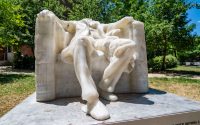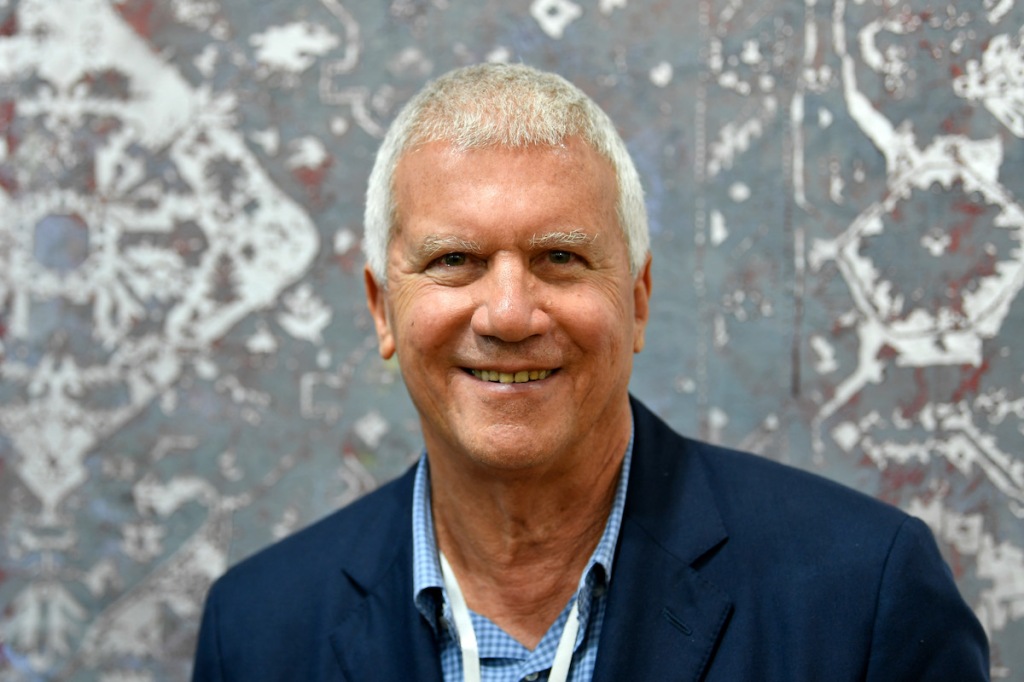AI Robot’s Painting Smashes High Estimate at Sotheby’s, Pompeii Victims Not Who Previously Thought, and More: Morning Links for November 8, 2024
To receive Morning Links in your inbox every weekday, sign up for our Breakfast with ARTnews newsletter.
The Headlines
PAINTING BY AI HUMANOID ROBOT SMASHES AUCTION PREDICTIONS. In a historic first, Sotheby’s sold a painting by an AI robot for $1,084,800 on Thursday. The house said 27 bidders battled for the portrait by the humanoid Ai-Da Robot depicting the computer science luminary and World War II decoder Alan Turing, titled A.I. God. Turing is considered the father of AI, and on Thursday evening’s Digital Art Sale, the large portrait of him fetched for far more than his estimated price of $180,000 from an unidentified bidder. Ai-Da, named after the first computer programmer, Ada Lovelace, was created by a team at the universities of Oxford and Birmingham, led by Aidan Meller. He told AFP “the greatest artists in history grappled with their period of time, and both celebrated and questioned society’s shifts.” His robot’s technology, he added, “is the perfect artist today to discuss the current developments with technology and its unfolding legacy.”
POMPEII DNA REVELATIONS. New DNA testing has upended long-held assumptions about the identities of many of the human remains found in Pompeii, who were victims of the eruption of Mount Vesuvius that buried them and their town under ash in A.D. 79. Frozen in time, some of the bodies of people found embracing or crouched, were for decades thought to be everything from a nuclear family, dubbed the “Family of the House of the Golden Bracelet,” or were known as the “Two Maidens,” because of an apparent embrace between what were thought to be young women. However, new genomic testing of their skeletal remains has proven such notions were simply imagined, romantic narratives, reports The New York Times. A team of scientists, including David Reich at Harvard University and David Caramelli at the University of Florence, have shown that an adult and younger child, thought to be a mother and her child, are in fact an adult male and unrelated boy. The individuals thought to be the nuclear family mentioned earlier, were unrelated, and one of the supposed, embracing maidens was a man unrelated to the woman, leading to yet another, possibly romantic assumption about them. The only apparent certainty is that we will never know exactly who these people were, and what they meant to each other.
The Digest
Yesterday Germany passed a resolution “to protect Jewish life,” with the intent to block government funding for cultural projects considered to have anti-Semitic messaging. The initiative has been met with controversy over protections of free speech and how to define anti-Semitism. [Monopol, Zeit, Taz]
Kitty Scott, the strategic director at Canadian charity Shorefast and its Fogo Island Arts program, will be the chief curator of the 15th Shanghai Biennale, held on November 8, 2025 to March 31, 2026 at the Power Station of Art (PSA). It will be titled “Does the flower hear the bee?” [ArtReview]
Le Monde’s editor-in-chief Michel Guerrin argues that Donald Trump’s win, “could signify the end of a resolutely identity-focused cultural and societal approach” in American culture. In his column for the center-left daily, he criticizes the “radical ‘woke-ism’” of the liberal American art world, which he says has every “interest” in dialling it down. “We went too far,” one unidentified American “figure of the art world” reportedly told the journalist during the current edition of Paris Photo, running through Sunday. [Le Monde]
Online bidding has started for “Dorothy’s” ruby slippers at Dallas’ Heritage Auctions. Actress Judy Garland wore the famed slippers in The Wizard of Oz film, but they were stolen from an exhibition by thieves who believed they were made of real rubies. After being missing for decades, the FBI found the shoes in 2018. Bidding continues through December 7. [CBC News]
The Kicker
TRANSFORMED BY MICHAEL HEIZER’S ‘CITY’. Writer William Van Meter describes for Artnet News his life-changing experience venturing into Michael Heizer’s sprawling land art masterwork built over 50 years, in Nevada’s high desert valley of the Great Basin, titled City. In a no-holds, emotive review coinciding with the artist’s 80th birthday, he shares his account of the monumental piece that can only be seen by six people at a time. “After having visited, I feel like the City experience has rewritten my DNA, or at least rebooted my brain,” writes Van Meter. What is it? He likens the piece to an Isamu Noguchi garden, or an alien city, full of ceremonial mounds, as well as portions that can echo modern, concrete architecture seen in “parking lots, and gutters.” This is added to traditional materials, and is ultimately reminiscent of monolithic wonders like the maoi of Rapap Nui or Stonehenge, he adds. An artwork that explores architecture, humanity and the self, it would seem. We are left only hoping to visit one day too.



